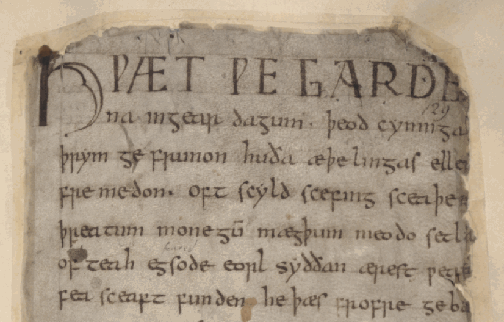Poetic Style
Almost all surviving Old English poetry is alliterative, meaning it creates rhythm using a pattern of stressed syllables that begin with the same sound. To adhere to the alliteration and meter, word order is often more fluid in poetry compared to prose and poets employ a number of rhetorical devices such as appositives: repitition of identity using a different phrase; and kennings: compound words which use figurative language to describe an object. These can make sentence structures confusing if you are unfamiliar with them so we will cover them here.
Also, it is worth noting that although Old English poetry is written identically to prose in manuscripts, editors often break poetry into lines and half-lines to make it easier for a modern reader - who may be unfamiliar with the meter - to understand. So while the opening to Beowulf looks like this in the manuscript:

Modern editions of the poem often break up the text to look like this:
þeod cyninga þrym gefrunon
hu þa aðelingas ellen fremedon
To understand why, we need to examine the meter of Old English verse. It is important to remember that Old English poetry is generally agreed to be composed for oral recitation, rather than simply to be read.
Alliteration and Stress
Alliteration is the repetition of a sound at the beginning of a syllable and stress is the emphasis placed on a syllable. The primary stress generally falls on the first syllable of a word, unless it starts with a prefix like 'ge', as prefixes are always unstressed. A line of poetry in Old English consists of two half-lines seperated by a natural pause known as a caesura, and each half-line has two stressed syllables.
The first heavily stressed syllable in the first half-line alliterates with the first heavily stressed syllable of the second half-line. Unaccented syllables are irrelevant to the metrical pattern. For example, in the line: 'Oft him anhaga are gebideð - Often the loner finds grace for himself', 'oft - often', 'anhaga - loner' and 'are - grace' alliterate and there is a short pause between 'anhaga' and 'are'.
As can be seen above, alliteration is based on sound, not letter. Vowels and diphthongs alliterate with each other. So stressed syllables beginning in 'o', like 'oft' can alliterate with stressed syllables beginning with any other vowel, like 'anhaga'. However consonant clusters alliterate only with themselves. For example, 'sp-', 'st-' or 'sc-' alliterate only with another syllable beginning with 'sp-', 'st-' or 'sc-'. They do not alliterate with each other or other words beginning with 's-'.
Because alliteration and meter are integral to surviving Old English verse, it can explain some awkward or strange sentences you run across. However, there are some other features you should be aware of.
Kennings and Appositives
Kennings are compound words which use more figurative language in place of nouns. For example, referring to blood as 'heaþoswata - battle sweat' or referring to the sky as 'heofones hwealf - heaven's vault'. By substituting nouns with more figurative language, poets increased the number of words that could be used to alliterate. Also, the fact they are compound words lends itself to the rhythms of Old English meter.
Appositives are nouns or noun phrases that follow or come before a noun, and specify who or what something is. For example, 'Him se yldesta andswarode, werodes wisa, word-hord onleac - To him the senior one answered, leader of the troop, unlocked his word-hoard'. The phrases 'the senior one' and 'leader of the troop' both refer to the same subject - in this case Beowulf - even though they are separated by the verb. This kind of variation is a common feature of oral poetry but can read awkwardly to a modern English reader. You can find an example of kennings and appositives in the below excerpt from Beowulf: 'Hæfde se goda Geata leoda cempan gecorone þara þe he cenoste findan mihte fiftyna sum sundwudu sohte secg wisade lagucræftig mon landgemyrcu - The worthy one had, from the Geatish peoples, chosen champions, those who were the boldest he could find; fifteen together, they sought the sea-wood, he led the warriors, that sea-skilled man, to the boundary of the shore'.
cempan gecorone þara þe he cenoste
findan mihte fiftyna sum
sundwudu sohte secg wisade
lagucræftig mon landgemyrcu
While the other rules of word order still generally apply to poetry, word order is often more fluid in order to conform to the stylistic features found in surviving Old English verse, so it is important to be aware of them.
Return to Prose Style Continue to Syntax Overview